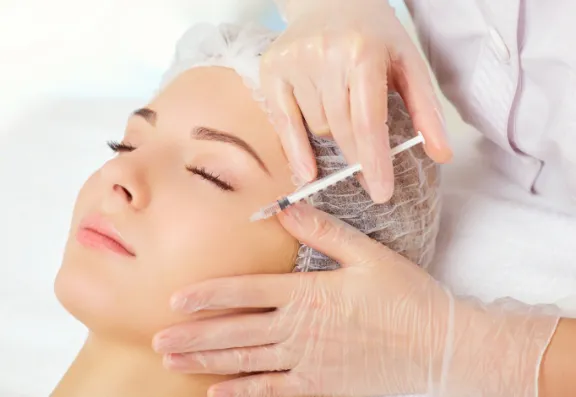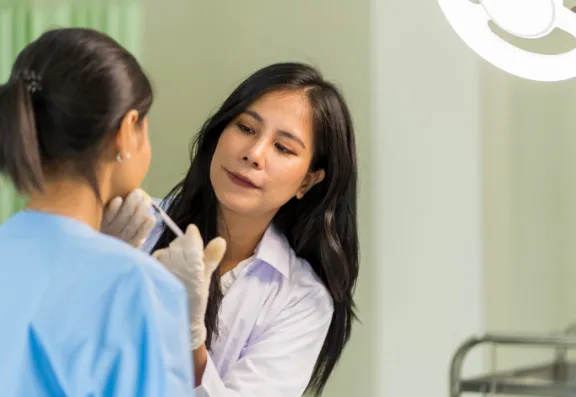Botox, a name that often conjures images of ageless celebrities and headline-grabbing cosmetic procedures, is far more than just a tool for aesthetic enhancement. In this comprehensive guide, we aim to unravel the mysteries surrounding Botox, delving into its nature, applications, and nuances of its use.
From its humble beginnings to its rise as a cornerstone in both medical and cosmetic fields, Botox's journey is a fascinating tale of scientific innovation and cultural impact. Our goal is to provide you with a clear, informed understanding of what Botox is, how Botox works, and why it continues to be a topic of interest and debate. Whether you're considering Botox for personal use or simply curious about its workings, this guide has everything you need to know about Botox.
Quick Summary
- Definition and Composition: Botox is a neurotoxic protein derived from Clostridium botulinum, used for both cosmetic and medical purposes.
- Main Uses: Cosmetically, it's primarily used to reduce facial wrinkles. Medically, it treats conditions like chronic migraines and excessive sweating.
- Safety and Side Effects: Generally safe when administered correctly, but potential side effects range from minor to severe.
- Procedure Expectations: The effects last about 3-6 months, with minimal discomfort during the procedure.
- Post-Treatment Care: Involves guidelines like avoiding rubbing the treated area to maximize effectiveness.
What Exactly is Botox?
Botox, scientifically known as Botulinum toxin, is a remarkable substance with a wide range of applications.
Definition and Composition: At its core, Botox is a neurotoxic protein derived from the bacterium Clostridium botulinum. It's known for its ability to temporarily paralyze muscles, which is the key to its effectiveness. By blocking nerve signals, Botox prevents muscles from contracting, leading to a reduction in the appearance of wrinkles and the treatment of certain medical conditions.
Historical Context of Botox: The journey of Botox from a scientific discovery to a household name is a testament to its versatility and effectiveness. Initially researched for its therapeutic potential, it later gained immense popularity in the cosmetic industry. Understanding its history provides insight into how Botox has evolved and become ingrained in modern medical and cosmetic practices.
Botox vs Other Brands: While Botox is a well-known brand name, it's not the only form of botulinum toxin available. Other brands include: Azzalure®, Dysport®, Xeomin®, Bocouture®, Vistabel® and DAXXIFY®.
How Botox Works?
Understanding the mechanism behind Botox's effectiveness is crucial to appreciating its diverse applications.
Mechanism of Action: Botox operates by targeting the nervous system, specifically the process that triggers muscle contraction. It temporarily blocks the release of a neurotransmitter, acetylcholine, at the neuromuscular junction. This interruption prevents muscles from contracting, thereby reducing wrinkles and treating certain muscle-related conditions.
Areas of Application: Botox's versatility is evident in the variety of areas where it can be applied. Commonly treated areas in cosmetic procedures include forehead lines, crow's feet, and frown lines. Medically, it's used in areas to treat conditions like muscle spasms and excessive sweating. The specific application depends on the individual's needs and the desired outcome.
Duration of Effects: The effects of Botox are not permanent. Typically, the results last between three to six months, depending on the area treated and individual factors like muscle strength and metabolism. Understanding this temporal nature is important for setting realistic expectations and planning for maintenance treatments.
Read more in our guide: How Does Botox Work?

Cosmetic Uses of Botox
Botox's most widely recognised use is in the cosmetic industry for its remarkable ability to smooth out facial wrinkles. It's particularly effective in treating dynamic wrinkles, which are formed by repetitive facial movements. Here are the key areas:
- Forehead Lines: Botox can significantly soften horizontal forehead wrinkles, giving a more relaxed and youthful appearance.
- Crow’s Feet: The fine lines around the eyes, often exacerbated by smiling or squinting, are effectively treated with Botox.
- Frown Lines: The area between the eyebrows, prone to deep furrows, can be smoothened.
Apart from these common applications, Botox is also used for other aesthetic purposes like eyebrow lifts, reducing the appearance of 'bunny lines' on the nose, and even in lip treatments for a 'lip flip'.
Medical Uses of Botox
Botox's applications extend beyond cosmetics into several medical fields. This section explores its role in treating various medical conditions.
Chronic Migraines: Botox has been a game-changer in treating chronic migraines. By reducing muscle tension and blocking pain signals, Botox can significantly decrease the frequency and severity of migraines.
Excessive Sweating (Hyperhidrosis): For individuals suffering from hyperhidrosis, Botox offers a reliable solution. By targeting sweat glands, it helps in reducing excessive sweating, improving comfort and quality of life.
Overactive Bladder: Botox is also effective in treating overactive bladder symptoms, providing relief from frequent urination and urgency.
Other Medical Conditions Treated with Botox: Beyond these, Botox is used for conditions like muscle spasticity, certain eye disorders, and more, showcasing its wide-ranging therapeutic potential.
The Safety Profile of Botox
General Safety: Overall, Botox has a strong safety profile when administered by qualified professionals. It’s important to understand the safety aspects to make informed decisions.
Potential Side Effects: While generally safe, Botox can have side effects, ranging from mild, like temporary bruising, to more severe but rare complications. Awareness of these is crucial for anyone considering Botox.
Contraindications: Certain conditions and situations, such as pregnancy or specific medical conditions, may contraindicate Botox use. Knowing these helps in ensuring safety and avoiding adverse reactions.
Preparing for Botox Treatment
Preparing for a Botox treatment is a crucial step towards ensuring a smooth and successful experience. The journey begins with an initial consultation, where a qualified practitioner will assess your facial areas, discuss your aesthetic goals, and consider your medical history. This session is pivotal for crafting a personalised treatment plan.
Next, adhering to pre-treatment guidelines is vital. These may include recommendations on lifestyle adjustments and medications to avoid, such as certain supplements and alcohol, aimed at reducing the risk of bruising or other complications.
Instructions on skincare or steps to take on the day of the treatment are also provided to optimise results.
Understanding the potential risks and outcomes is equally important. Educating oneself about the possible side effects and setting realistic expectations can help in making an informed decision. It's also crucial to disclose any allergies or previous reactions to ensure your safety.
Emotional and psychological preparation should not be overlooked. The decision to undergo a cosmetic treatment like Botox can have emotional impacts. Approaching the treatment with a balanced mindset and realistic goals is key to a satisfactory outcome.
Lastly, planning for the treatment day, including logistics like transportation and scheduling, ensures a stress-free experience. It's also wise to make arrangements for any necessary post-treatment care or downtime.
By methodically preparing for Botox treatment, individuals can ensure they are well-informed, comfortable, and ready for the procedure, thereby enhancing the likelihood of a positive outcome.

The Botox Treatment Process
Understanding the treatment process can alleviate anxieties and prepare you for what to expect.
During the Procedure
The Botox treatment itself is a quick and minimally invasive process. It typically begins with the practitioner marking the specific areas on your skin where the Botox will be injected. A topical anaesthetic or cooling device may be used to minimise discomfort. The practitioner then uses a fine needle to inject small amounts of Botox into the targeted muscles. The number of injections depends on various factors, including the extent of the area being treated and the desired effect.
Immediate Post-Treatment Care
Immediately following the procedure, it's crucial to follow specific care instructions to ensure the best results. This might include avoiding lying down for a few hours and refraining from strenuous activities for a short period. Patients are usually advised not to rub or massage the treated areas to prevent the Botox from spreading to unintended muscles.
Long-Term Maintenance
The effects of Botox are temporary, typically lasting between three to six months. For sustained results, regular follow-up treatments are necessary. Your practitioner will advise you on the optimal frequency of treatments based on your individual response and aesthetic goals. It's important to maintain a schedule for touch-ups to continue enjoying the benefits of Botox.
Choosing a Qualified Practitioner
Selecting an adept practitioner for Botox treatments is as important as the decision to have the treatment itself. It involves several considerations:
- Medical Qualifications: Ensure the practitioner has recognised medical credentials. Look for qualifications in dermatology or cosmetic surgery, indicating a thorough understanding of facial anatomy.
- Specialisation in Botox Treatments: Preference should be given to practitioners who specialise in Botox and have a proven track record.
- Consultation Process: A good practitioner will provide a comprehensive consultation, assessing your facial structure, discussing your aesthetic goals, and explaining the procedure, potential risks, and expected results.
- Reputation and Reviews: Research their reputation. Read reviews, ask for recommendations, and consider before-and-after photos of their previous work.
- Clinic Accreditation: Verify the clinic's accreditation to ensure it meets health and safety standards.
- Personal Comfort: It's essential that you feel comfortable and confident with your practitioner. They should be willing to answer all your questions and address your concerns.
- Follow-Up Care: Check if they offer follow-up care to monitor the results and manage any potential side effects.
Read more in our guide: Who should You Trust to do Your Botox?
Cost and Insurance Considerations
The cost of Botox will vary from region to region, to the experience of the injector and which brand they use.
- Average Cost of Botox: The typical price range for Botox treatments, which can vary based on geographic location, the experience of the practitioner, and the amount of Botox used. See our How Much Is Botox? guide for more information.
- Factors Influencing Cost: Treatment area, the number of units needed, and the frequency of treatments impact the overall cost.
- Insurance Coverage: Some Botox treatments might be covered by insurance, particularly for medical conditions and the importance of checking with insurance providers.
- Budgeting for Treatment: Discuss with your practitioner any potential payment plans or financial assistance for those using it for medical reasons.
Conclusion
In this comprehensive exploration of Botox, we've delved into its various facets, from its medical and cosmetic applications to the safety considerations and personal experiences of those who've used it. Botox, more than just a tool for aesthetic enhancement, offers significant benefits in treating a range of medical conditions.
The importance of choosing qualified, medical practitioners and having realistic expectations cannot be overstated.
As we've seen, while Botox has its limitations, its effectiveness in the right circumstances is undeniable. Ultimately, the decision to use Botox should be an informed one, based on a thorough understanding of its potential and limitations. This guide has aimed to provide that understanding, empowering you to make choices that align with your personal health and aesthetic goals.
Book Your Botox Consultation Today
As you will have learnt, Botox is a great tool to help you look younger and fresher. It’s important that you get treated by an experienced, medically trained, and qualified practitioner who will inject you safely.
As always, if you have any questions you can use our Botox Q&A where you can ask for more advice direct from a trusted, experienced medical practitioner.

Author: Anna Kremerov
Mrs Anna Kremerov is an award-winning Nurse Practitioner known for Aesthetic Medicine and non-surgical procedures. She is the Founder of Anna Medical Aesthetics, the only CQC registered aesthetic medical practice in Swindon and a MaiLi Centre of Excellence for the South West of England.
Anna and her team have built up an impeccable reputation with over a hundred 5-star patient reviews on Google and Trustpilot.
Anna has over 22 years of combined medical experience in Intensive Care, Woman Health, Primary Care and Aesthetics Medicine.

